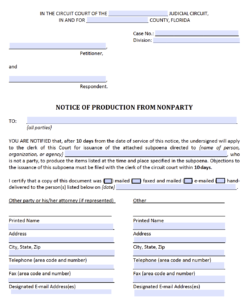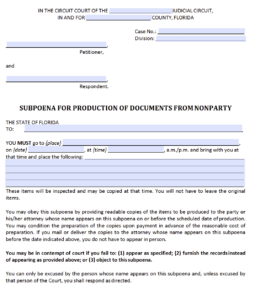How to get text messages with a subpoena
Injunctions (also known as restraining orders) have serious consequences. The ability to obtain records like text messages is often critical evidence in stalking or domestic violence-type restraining order hearings.
This video explains how to get text messages admitted at an injunction hearing in Florida. It also details how to get a subpoena to send to service providers – in other words, how to compel third parties (like AT&T or Verizon) to turn over their records to prove you are being stalked or harassed by someone specifically. Alternatively, this method can be used to prove you did NOT stalk or harass someone.
Text messages are admissible in Florida courts to get an injunction or to defend against an injunction.
But you need to prove that the texts are authenticated or the court may not consider them as evidence.
There are various ways to do this.
- Screenshots of the texts.
- Cell phone records of the messages.
- Getting subpoenas from the cell phone service provider – but that one can be tricky.
Most of the time, you only need screenshots of the texts. If you can testify that the person who sent those texts is the other person, the judge should let them in.
If you need to get subpoenas for text records from a service provider, that can get expensive. But we know exactly how to do it. The process I am about to explain takes patience, organization, and determination. That’s why most people give up – and that’s why attorneys who handle injunctions can charge a lot of money to do it for you.
Here it is in a nutshell:
So we know that sometimes people will use other phones to send texts or go online and send spoof or fake text messages from an app or website. How do you prove that it’s the other person?
You can start with sending requests for admissions, interrogatories, and taking depositions of any witnesses related to the case. Once you’ve locked in what phone numbers, e-mails, and computers (IP addresses) the other person used, you can then begin the process of getting the records from the service providers.
STEP 1: File a notice of production from a nonparty and the subpoena for the production of documents from the nonparty (Google, AT&T or Verizon, for example). You also have to send both those documents to the other party or their attorney.
STEP 2: Wait 10 days (or 15 days if you send the notice by e-mail) to see if the other party objects.
If the other side objects, you may have to have a hearing to see if the judge will allow the subpoena for records. Most times, however, there will be no response from the other side, and you can just move right on to step 3.
STEP 3: After the waiting period, get the clerk of court to sign the subpoena and send it to the service provider. You can usually do that by e-mailing it to the service provider’s custodian of records – and that’s pretty to find online with a simple search.
STEP 4: Once you get the records, you can provide them to the other party (or wait for them to request copies).
So there you go. Now you know how to get text messages (or even e-mails) from a service provider in an injunction case.
If we can be of any further assistance to you, please don’t hesitate to reach out to us at 407-344-4837.
FAQ About Subpoenaing Text Messages in Florida Injunction Cases
1. How much does it cost to subpoena text messages?
The cost of subpoenaing text messages varies depending on the service provider and the complexity of the case. Some providers charge a standard processing fee, while others may require additional costs based on the volume of records requested. Legal fees for filing subpoenas and handling objections can also increase expenses. Hiring an attorney experienced in injunction cases can streamline the process and ensure that the request is properly handled.
2. How can I get text messages thrown out of court?
To challenge the admissibility of text messages in court, you can argue that they are not properly authenticated, were obtained illegally, or lack relevance to the case. If there is no proof that the sender was the alleged party, the judge may exclude the messages. Additionally, if the messages were altered, obtained without proper consent, or violated privacy laws, they may not be allowed as evidence. An attorney can help file objections and present legal arguments to exclude text messages.
3. How far back can you subpoena text messages?
The timeframe for retrieving text messages depends on the specific service provider’s retention policies. Most providers only store text message content for a short period, often ranging from a few days to a few months. However, phone records showing the date, time, and recipient of a message may be available for a longer duration. To maximize the chances of obtaining relevant records, subpoenas should be filed as soon as possible.
4. How long does it take to subpoena phone records, including text messages?
The process of subpoenaing phone records can take several weeks or even months. After filing the notice of production from a nonparty, there is typically a 10- to 15-day waiting period to allow for objections. Once the subpoena is approved and sent to the service provider, response times vary. Some providers process requests within a few weeks, while others may take longer, especially if they require additional documentation or legal proceedings.
5. How can I prove spoofing in a legal case?
Proving that someone sent spoofed or fake text messages in a cyberstalking injunction case for example, requires gathering technical and circumstantial evidence. This may include obtaining IP address records, metadata from service providers, and testimony from forensic experts. Requesting admission of key facts, conducting interrogatories, and analyzing the sender’s device history can help demonstrate that a message was fabricated. If you suspect spoofing in a stalking or injunction case, consulting an attorney familiar with digital forensics can strengthen your case.
free case evaluation
Fill out the form below for an free evaluation of your case.




Orlando Injunction Attorney
- Consequences of Getting an Injunction On Your Record
- Dating Violence Injunction in Florida
- Exploitation of a Vulnerable Adult
- Florida Domestic Violence Injunctions
- Florida Sexual Violence Injunctions
- How to Appeal a Final Order of Injunction
- How to FIGHT AGAINST an Injunction or Restraining Order
- How to File an Injunction or a Restraining Order in Florida - For Victims
- How to get text messages with a subpoena
- How to Seal or Expunge a Restraining Order or Injunction
- Orlando Stalking Injunction Lawyer
- Repeat Violence Injunctions in Florida
- Secretly Recording Other People in Florida

Practice Areas
Learn more about our services in Criminal Defense, Personal Injury, and Injunctions.

We Fight for Outstanding Case Results
We are driven to get you results. Review the outcomes on recent cases we've handled.




